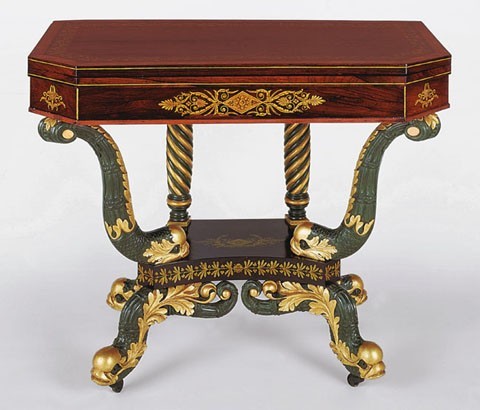
Card table attributed to Deming and Bulkley, New York City, ca. 1825. Rosewood and satinwood veneer with white pine. H. 30", W. 37 1/8", D. 18 1/2". (Private collection; photo, Gavin Ashworth.)
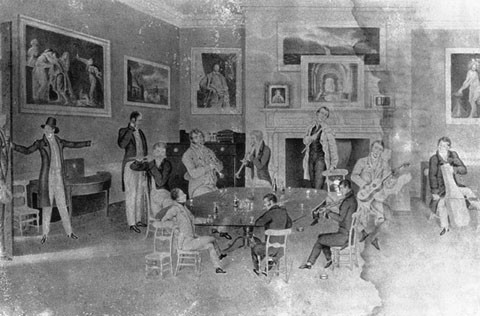
Thomas Middleton, Friends and Amateurs in Musick, Charleston, 1827. Wash drawing with touches of white on paper. (Courtesy, Gibbes Museum of Art/Carolina Art Association, gift of Henry Cheves.) This 1827 drawing of Arthur Middleton’s house depicts an elite Charleston interior with its large painting collection and inherited furniture from earlier periods. The rush-seated fancy chairs and sideboard are typical of northern furniture shipped to Charleston from 1810 to 1840.
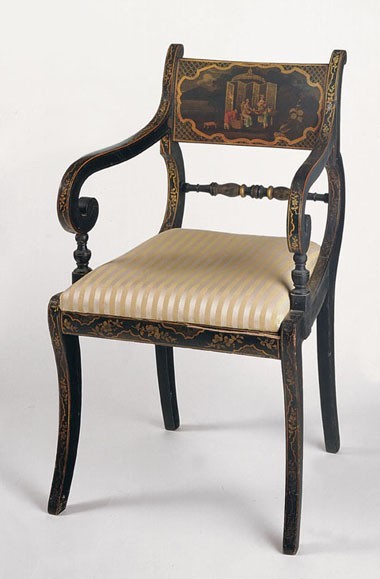

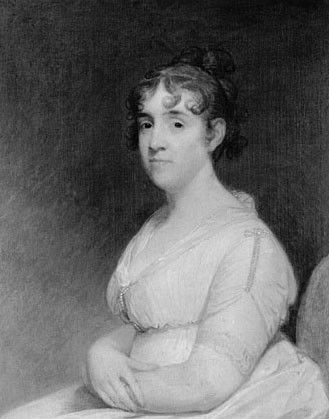
Gilbert Stuart, Sarah I’on Lowndes,Washington, D. C., ca. 1803. Oil on canvas. (Courtesy, Gibbes Museum of Art/Carolina Art Association, bequest of Mrs. Royal Phelps Carroll.)
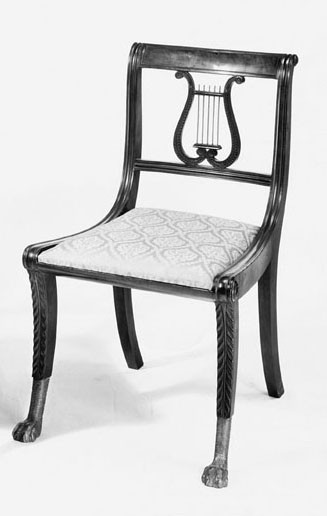
Side chair attributed to Duncan Phyfe, New York City, ca. 1815. Mahogany; secondary woods and dimensions unrecorded. (Courtesy of Sack Heritage Group.) www.sackheritagegroup.com
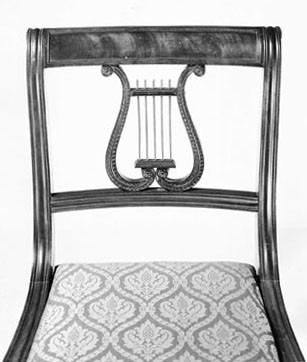
Detail of the carved lyre back of the side chair illustrated in fig. 6. (Courtesy of Sack Heritage Group.) www.sackheritagegroup.com

Side chair, New York City, ca. 1815. Mahogany with ash. H. 33", W. 16 3/4", D. 22". (Private collection; photo, Gavin Ashworth.)
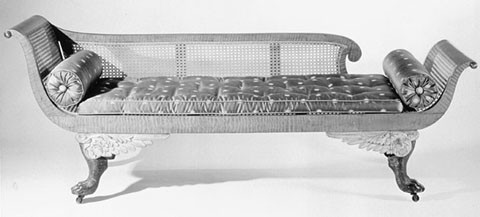

Card table attributed to Charles Honoré Lannuier, New York City, ca. 1815. Mahogany; secondary woods and dimensions unrecorded. (Private collection.)
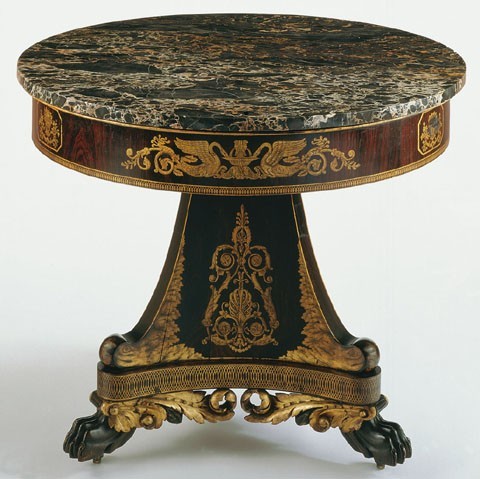
Center table by Deming and Bulkley, New York City, 1828. Rosewood veneer with white pine and ash. H. 30 1/2", Diam. 36". (Private collection; photo, Gavin Ashworth.)
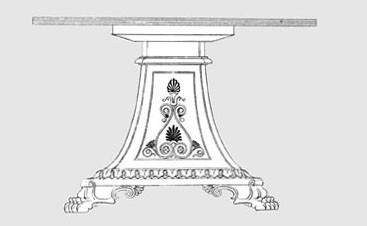
Design for a round monopodium or table illustrated on pl. 39 in Thomas Hope, Household Furniture and Interior Decoration (1807). (Courtesy, Winterthur Museum.)

Detail of the freehand gilded decoration on the pedestal of the center table illustrated in fig. 11. (Photo, Gavin Ashworth.)

Design for a center table illustrated in Rudolph Ackermann’s Repository of Arts, Literature, Commerce, Manufactures, Fashions and Politics, May 1825, pp. 305–6. (Courtesy, Winterthur Museum.)
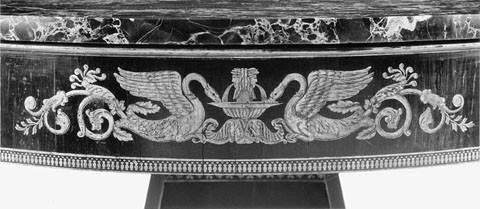
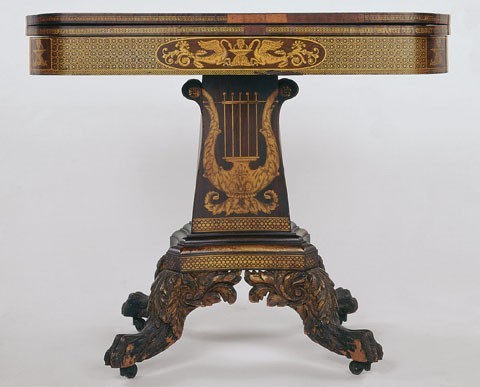
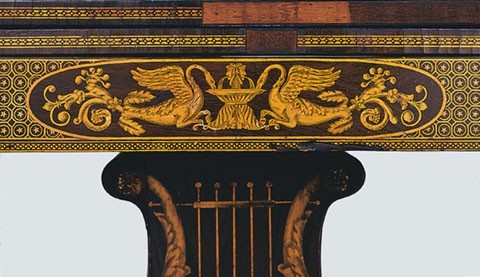
Detail of the gilded swan decoration and cell-pattern diapering on the skirt of the card table illustrated in fig. 16. (Courtesy, Charleston Museum, Charleston, South Carolina; photo, Gavin Ashworth.) http://charlestonmuseum.org
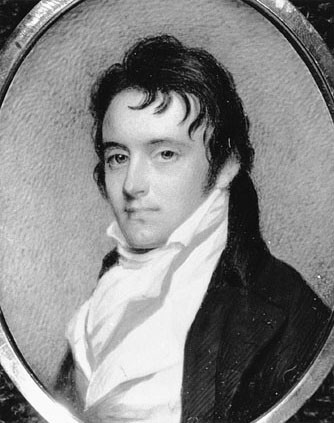
Edward Greene Malbone, Colonel Thomas Pinckney, Charleston, ca. 1804. Watercolor on ivory. (Courtesy, Gibbes Museum of Art/Carolina Art Association.)

Card table attributed to Deming and Bulkley, New York City, ca. 1825. Rosewood veneer with white pine, tulip poplar, and oak. H. 29 1/4", W. 37 1/4", D. 18 3/4". (Courtesy, The Charleston Museum, Charleston, South Carolina; photo, Gavin Ashworth.) http://charlestonmuseum.org

Detail of the grapevine border and flower basket on the top of the card table illustrated in fig. 19. (Courtesy, The Charleston Museum, Charleston, South Carolina; photo, Gavin Ashworth.) http://charlestonmuseum.org
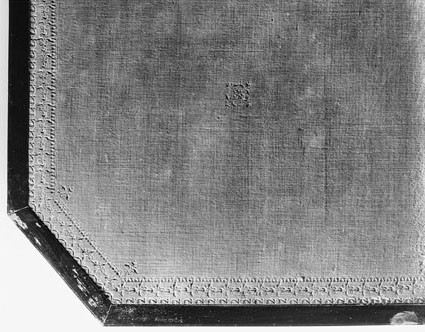
Detail of the velvet playing surface on the card table illustrated in fig. 19. (Courtesy, The Charleston Museum, Charleston, South Carolina; photo, Gavin Ashworth.) http://charlestonmuseum.org

Card table illustrated in fig. 1 opened to the original velvet playing surface. (Photo, Gavin Ashworth.)
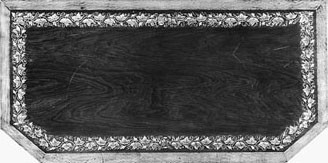

Card table attributed to Deming and Bulkley, New York City, ca. 1825. Mahogany veneer with white pine, beech, oak, and poplar. H. 283/4", W. 37 1/4", D. 18 3/4". (Courtesy, The Charleston Museum, Charleston, South Carolina; photo, Gavin Ashworth.) http://charlestonmuseum.org
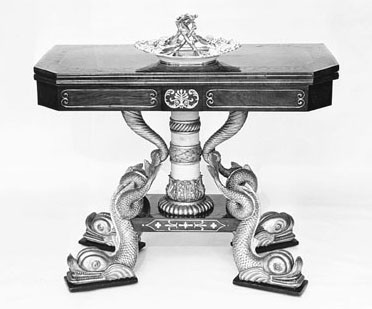
Card table, English, ca. 1813. Rosewood veneer with brass inlay; secondary woods and dimensions unrecorded. (Courtesy, Royal Pavilion, Brighton, England.)
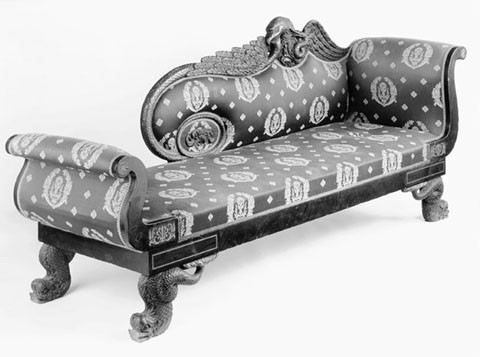
Recamier attributed to Deming and Bulkley, New York City, ca. 1830. Rosewood veneer and mahogany with oak, ash, and poplar. H. 38 1/2", W. 90 1/2", D. 25". (Courtesy, The Charleston Museum, Charleston, South Carolina; photo, Gavin Ashworth.) http://charlestonmuseum.org

Detail of the crest rail on the recamier illustrated in fig. 26. (Courtesy, The Charleston Museum, Charleston, South Carolina; photo, Gavin Ashworth.) http://charlestonmuseum.org
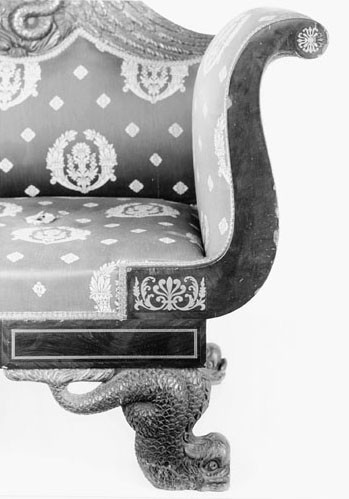
Detail of an arm, foot, and brass inlay on the recamier illustrated in fig. 26. (Courtesy, The Charleston Museum, Charleston, South Carolina; photo, Gavin Ashworth.) http://charlestonmuseum.org
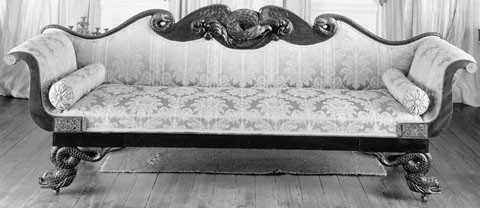
Sofa, New York City, ca. 1830. Mahogany and mahogany and rosewood veneer; secondary woods unrecorded. H. 38", W. 99", D. 25 1/2". (Private collection; photo, Gavin Ashworth.)

Armchair by Deming and Bulkley, New York City, 1821. Maple. H. 33", W. 20 1/2", D. 17 1/2". (Courtesy, St. John’s Lutheran Church; photo, Gavin Ashworth.)

Detail of the grapevine border and carved eagle heads on the lyre back of the armchair illustrated in fig 30. (Photo, Gavin Ashworth.)
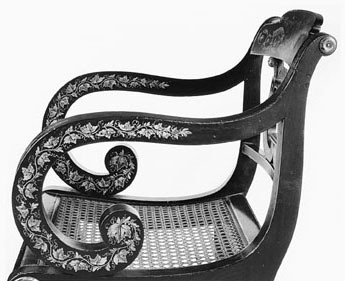
Detail of the grapevine border on the arms of the armchair illustrated in fig. 30. (Photo, Gavin Ashworth.)
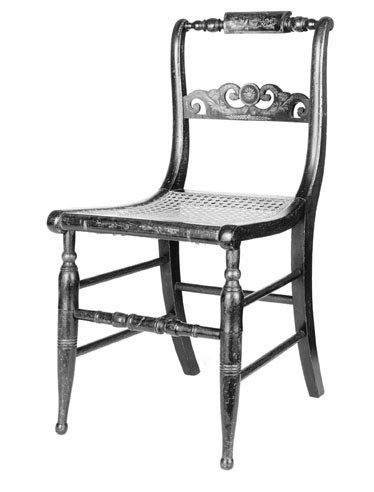
Painted side chair attributed to Deming and Bulkley, New York City, ca. 1825. Maple. H. 33 3/4", W. 16 3/4", D. 21 1/2". (Private collection; photo, Gavin Ashworth.)
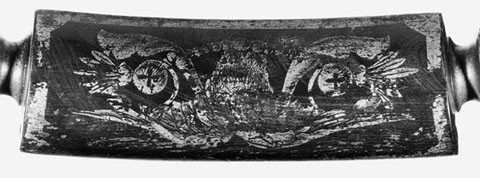
Detail of the freehand gilded eagle on the crest rail of the side chair illustrated in fig. 33. (Photo, Gavin Ashworth.)
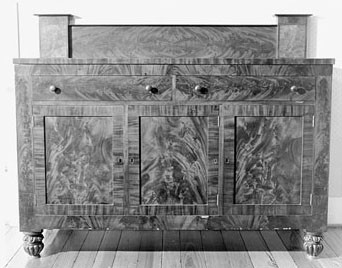
Sideboard by Deming and Bulkley, New York City, 1825. Mahogany veneer with tulip poplar and white pine. H. 52 1/2", W. 66 3/16", D. 24 5/8". (Private collection; photo, Museum of Early Southern Decorative Arts.)
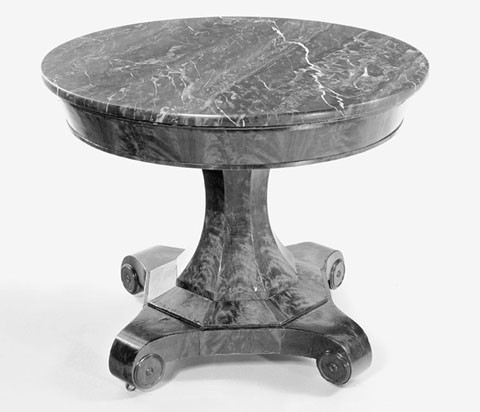
Center table with partial label by Deming and Bulkley, New York City, ca. 1835. Mahogany veneer with ash and white pine. H. 29 1/2", Diam. 35 3/4". (Private collection; photo, Museum of Early Southern Decorative Arts.)

Secretary-and-bookcase with partial label by Deming and Bulkley, New York City, ca. 1835. Mahogany veneer with cedrela, white pine, and tulip poplar. H. 87 1/2", W. 73 1/2", D. 48 1/2". (Private collection; photo, Gavin Ashworth.)
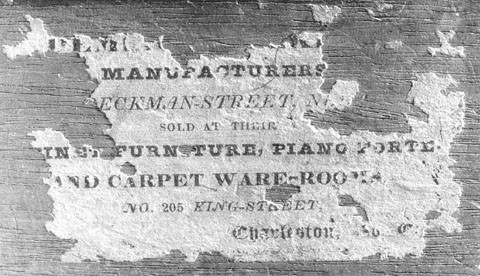
Detail of the Deming and Bulkley label on the secretary-and-bookcase illustrated in fig. 37. (Photo, Gavin Ashworth.)
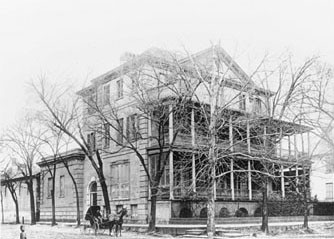

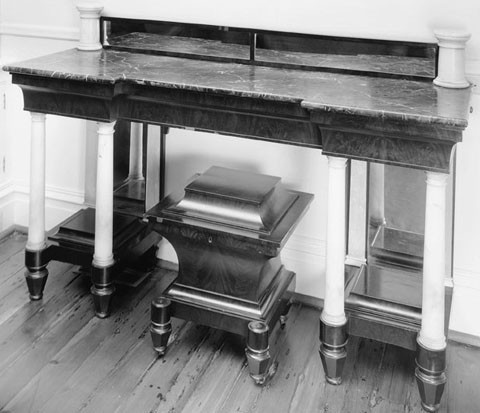
Sideboard and cellaret attributed to Deming and Bulkley, New York City, ca. 1835. Mahogany veneer with white pine. H. 48 1/2", W. 73 1/2", D. 25". (Private collection; photo, Gavin Ashworth.)
In 1774, Charleston, South Carolina, was the fourth largest urban center in British North America and the largest seaport in the South. The free people living there had a per capita wealth more than ten times greater than colonists in New England and more than nine times greater than colonists in the Middle Colonies. Bostonian Josiah Quincy remarked that Charleston, “in grandeur, splendour of building, decorations, equipages, numbers, commerce, shipping and indeed in almost everything . . . far surpasses all I ever saw, or ever expected to see, in America!” Despite a relative decline in the city’s economy during the early nineteenth century, Charleston still had a per free capita wealth more than three times that of Massachusetts and New York in 1860. With its superior wealth, Charleston constituted a sophisticated and perhaps unique place within the American furniture market.[1]
Before the American Revolution many of Charleston’s wealthiest citizens procured their furniture and other luxury items from Europe, but during the early nineteenth century, as direct trade with Europe declined, they increasingly turned to northern cities for fashionable goods. New York eventually became the primary exporter of Charleston’s agricultural staples and the principal source for goods imported from abroad. New York cabinetmakers moved quickly to assume control of the furniture market vacated by European imports. Cabinetmakers, such as Duncan Phyfe, Charles Honoré Lannuier, and others, offered richly gilded and boldly carved classical furniture for the elite market. Simple mass-produced items, often shipped as venture cargo or warehoused by local merchants and cabinetmakers, flooded Charleston’s middle class market. At the same time, one New York cabinet firm, Deming and Bulkley, offered Charlestonians “beautiful specimens” of their furniture in “elegant patterns . . . which will not suffer in comparison with the best specimens ever imported from Europe” (fig. 1). Most of the New York furniture that descended in Charleston families has bold figural carving and elaborate gilded decoration based on European classical designs. These pieces represent a unique body of New York classical furniture made especially for the southern market.[2]
Imported Furniture and European Taste
At the beginning of the nineteenth century, Charleston had a long-established tradition of importing expensive European art and furniture. Perhaps more than any other Americans, Charlestonians patronized European artists such as Thomas Gainsborough, Allan Ramsay, George Romney, Joshua Reynolds, Johann Zoffany, Benjamin West, and John Singleton Copley. Throughout the nineteenth century, Carolinians were inveterate grand tourists. The typical painting collection of a Charleston aristocrat would have included paintings thought to be by Guido Reni, Raphael, Angelica Kauffmann, Salvator Rosa, and others (fig. 2). In 1802, South Carolina planter and governor John Drayton described Charlestonians as “too much prejudiced in favour of British manners, customs, and knowledge.” Drayton concluded:
Among the richer part of the community of this state, the modes of living are similar to those of the same rank in European nations. Like them, they enter into the change of fashions; perhaps directed by many of their whims, and influenced by many of their follies. Their equipages are costly and numerous, their servants many; and hospitality throughout the state is known to be a national virtue.
Charlestonians’ wealth, extravagance, and predilection for European customs inevitably influenced their taste in furnishings and interior decoration.[3]
Charlestonians were among the first Americans to demonstrate a taste for the archaeologically based, classical styles published by furniture designers such as Thomas Sheraton, Thomas Hope, George Smith, and Rudolph Ackermann. After browsing through the shops of several Parisian cabinetmakers in 1797, Charlestonian Mary Stead Pinckney (d. 1812) wrote a letter to her cousin, Margaret Izard Manigault (1768–1824), describing new-styled mahogany secretaries, console tables, and “a plain mahogany commode with bronze feet a l’antique.” Pinckney had discovered the new taste for vert antique decoration and explained “the bronze is only as an appearance & is wood painted in imitation of bronze.” Pinckney was most enthused by the furniture in the shop of Georges Jacob (1739–1814), the French cabinetmaker who employed the classical innovators Charles Percier (1764–1838) and Pierre Fontaine (1762–1853) as designers. She exclaimed, “the furniture at Jacob’s. I had no idea that Paris boasted of any so beautiful. The new chairs are bewitching . . . I want to give you an idea of the new shape.” Pinckney described the fashion for scroll-back chairs and the new klismos style: “The back & also the seat is all of one width, carried up very high with a gentle curve till it turns & curls back. When they are not in imitation of bronze the backs are covered like the seat, yellow striped velvet, for example, trimmed with deep fringe orange & black, &c., and the end of the curve on the back of the chairs also trimmed.” A Parisian friend of Pinckney’s cousin envisioned Margaret Manigault reclining on a sofa in the “Greek manner.” She wrote, “If by a magic wand I could evoke in your bedroom a mahogany sofa trimmed with a handsome green material embroidered in brown and a draped Etruscan fringe in the most Greek manner it seems that I would see you resting there with greater ease.”[4]
Despite such tantalizing documentary evidence, surviving furniture suggests that Charlestonians imported the great majority of their classical furniture from England rather than from France during the early nineteenth century. One of the most important examples of English classical furniture with a Charleston history is the set of black and gold japanned seating furniture owned by General Thomas Pinckney (1750–1828). The surviving set includes eight armchairs (fig. 3) and one side chair in the klismos form, and a recamier sofa. Each piece is decorated in imitation of Chinese lacquer, with gilded decoration on a black ground and polychrome-painted chinoiserie scenes on the backs of the chairs and on the sweeping scroll arms of the recamier sofa; each scene is surrounded by gilded cell-pattern diapering (fig. 4). A nearly identical set (except for the tablets that depict English pastoral landscapes) belonged to Pinckney’s brother and his wife, General Charles Cotesworth and Mary (Stead) Pinckney. Their furniture typifies the Charleston taste for brightly gilded and painted furniture and represents the highest end of English Regency design. These suites are the precursors of future New York imports, for although the source for imported goods changed, Charlestonians’ taste for carved and gilded classical furniture remained constant. Margaret Manigault noted this predilection when describing her brother’s house:
[It] is in excellent order, & very handsomely furnished. The Drawing Room with rich Chintz curtains lined with yellow, a beautiful rich carpet, chairs & sofas of cane of the most fashionable make, handsomely painted & gilt. They are black & gold with thick yellow cushions.[5]
The 1807 Embargo and the War of 1812
Charleston’s reliance on Europe for fashionable furniture was disrupted by a nine-year series of events that included the British and French blockades of 1806, Thomas Jefferson’s embargo in 1807, the non-intercourse acts of 1809, and the War of 1812. Economic historians generally consider this period the principal turning point in Charleston’s antebellum commercial history. Previously, Charleston had enjoyed great prosperity as a center for trans-Atlantic trade with Europe and the West Indies, especially following the American Revolution when the city’s merchants capitalized on America’s neutral position in the English and French conflict, serving as the leading depot for shipping between Europe and the West Indies. The economic depression created by the blockade, the embargo, the non-intercourse acts, and the War of 1812 decimated Charleston’s mercantile community to the extent that it never fully recovered. Artist Charles Fraser recalled how the embargo’s results were “extensively and so ruinously experienced.” In his 1854 Reminiscences, Fraser explained that during this period, “Capital declined, vessels disappeared, prices fell, produce accumulated . . . non-intercourse, embargo, war, paralyzed commercial enterprize; and so great, at length, became their [Charleston merchants’] depression, that scarcely a ship was owned in Charleston . . . grass was growing upon our wharves.”[6]
The impact of the embargo and the war on consumerism is documented in letters from Margaret Izard Manigault to her mother, Alice Delancey Izard. In February 1809, Manigault remarked, “The effects of the Embargo are so severely felt here that there have been few parties this winter. Those families which used to give them are constrained to remain quietly in the country & live upon their poultry.” One month later, Manigault lamented over how the embargo prevented her and her husband from celebrating the marriage of their nephew, Arthur Middleton (1785–1837), to Alicia Hopton Russell (1789–1840), the daughter of Nathaniel Russell (1738–1820), Charleston’s leading post-Revolutionary merchant. “I cannot help wishing,” she wrote, “that we too could welcome the bride into her new family. But we are not provided & the China, & glass, & even Candlesticks, & spoons, & various we thought of . . . which the circumstances of the Times will not allow us to procure.” The collapse of direct trade with Great Britain forced Charlestonians to find new sources for many of their luxury goods. In 1811, Margaret Manigault informed her mother that she had just received from New York a set of white and gold painted fancy chairs with Grecian decoration in “a modern handsome shape.” She concluded with satisfaction, “When I want chairs again, I shall certainly send to New York for them!”[7]
The English furniture industry struggled to maintain its position in Charleston after the resolution of the War of 1812. In 1817, for example, Charles Cotesworth Pinckney imported an extensive set of English-made, rosewood seating furniture stamped by Gillows. Writing from London, Isaac Coffin assured the Pinckneys that their new furniture was “all the fashion in the Houses of the first Nobility and Gentry in England . . . made by Mr. Gillow at Lancaster . . . the first Upholsterer in the Kingdom.” Similarly, upholsterers Barelli, Torre & Co. advertised in 1819:
ELEGANT WINDOW CURTAINS, Of rich Crimson Damask, lined with yellow silk and ornamented with fine colored Brocade Lace, with gilt cornices and an Eagle in the centre, finished after the fashion and style of those used in the best rooms in England, having been just imported from London by order of a gentleman in Carolina, who declined taking them, being too rich a Furniture for his Country Seat.
From 1818 until 1821, Charleston merchant John Woddrop regularly imported and advertised as venture cargo an assortment of “London made furniture,” consisting of “fashionable Sideboards, sets of Dining Tables, Secretaries and Book Cases, Chests of Drawers, Looking Glasses, and a variety of cane seat Chairs.” By 1821, however, imported English furniture was less affordable, and Woddrop’s last advertisements suggest that he had retired from the furniture trade: “The Articles remaining on hand are offered at prices considerably under cost and charges.” The 1824 tariff act placed a 30 percent ad valorem tax on foreign furniture, sounding the final death knell for Charleston’s tradition of importing English furniture. Merchant J. N. Cardozo recalled that, by this time, “the class of merchants who grew out of the direct foreign trade of Charleston with the ports of Europe . . . had withdrawn from business or were dead. . . . The Russells, Crafts, Winthrops, Tunnos, Hasletts, Hazlehursts, were replaced by those who were connected with the indirect trade through Northern ports—with the shipment of produce through New York.”[8]
New York Furniture for the Charleston Market
In the early decades of the nineteenth century, shipments of northern-made furniture and other domestic goods began arriving in Charleston as makers and merchants sought to expand their markets by capturing a portion of the potentially lucrative southern trade. There were several different channels through which local patrons could purchase northern goods. The four primary sources were speculative cargo shipped to Charleston, cabinet warehousing by local merchants, supplementary warehousing by local cabinetmakers, and custom commissions requested by a local patron. In the late 1810s the market was crowded with furniture from London, New York, Philadelphia, Boston, Salem, and Providence, Rhode Island. As the market settled in the 1820s, Philadelphia chairmakers managed to establish control over a significant portion of the fancy and Windsor chair market, whereas New York makers established their control over the remainder of the furniture market. By the 1830s, even the competition from Philadelphia had faded away, and New York reigned supreme as furniture supplier to the Charleston market.
Venture Cargo
One of the ways that northern furniture first reached the Charleston market was through speculative or venture cargo. Numerous advertisements featured assorted furniture being sold on or near the wharves, sometimes directly from the ship itself—as in 1815 when three-dozen fancy chairs and six-dozen Windsor chairs arrived on board the sloop Schoharie. Most often this furniture was from New York or Philadelphia, but cabinetmakers from elsewhere also tested the waters. The most common channel of distribution was for a chairmaker or furniture maker to consign his goods to either a general retail merchant or a furniture retailer in Charleston. It was also quite common for the shipmaster himself to buy goods in his home port and bring them to Charleston. At that point he either sold them himself, consigned them to a local auction house, or sold them to a local merchant.[9]
During the earliest years of this speculative trade, most of the venture cargo was aimed at the middle and lower ends of the market. Shipments were usually small, consisting of only a few dozen chairs or fewer than a dozen case pieces. Most of the local distributors were merchants who maintained shops near the wharves rather than furniture retailers. In January 1816, Edward Gamage and Co. offered their most extensive assortment to date, which included a few sets of bamboo chairs and gilded chairs, three-dozen Windsor chairs, three-dozen slat-back chairs, two-dozen bent chairs, and one set of tortoise chairs. That same month the mercantile firm of S. Davenport & Co. offered two secretary-and-bookcases, two bureaus, two ladies’ work tables, one sideboard, and two dressing tables. Despite the occasional offering of case pieces, chairs remained the most frequently offered speculative cargo. In 1818, for example, merchant J. D. Stagg advertised New York fancy chairs of the “latest fashion,” including eight-dozen slat-back chairs, one-dozen scroll-fret chairs, one-dozen burr-back chairs, and one-dozen ball-back chairs, all in elaborately ornamented, gilded curled maple.[10]
Auction firms sold much of the speculative cargo shipped to Charleston. In 1816, Morton A. Waring offered “a quantity of excellent . . . furniture” that included card, dining, and chamber tables, a wardrobe, a set of drawers, a bed, and japanned chairs. When William A. Caldwell & Co. offered a quantity of New York furniture in 1820, they suggested that local cabinetmakers attend, for all the furniture was to be sold cheap for cash in order to “close a consignment and to meet advances made thereon.” Obviously, some of the speculative cargo ventures were more successful with Charlestonian patrons than others.[11]
Although the makers of venture cargo furniture generally remained anonymous, some individuals tried to capitalize on the cachet of “name-brand” goods. In 1819, the Charleston Auction Establishment advertised furniture of “superior quality and workmanship” by J. L. Everitt of New York. The description of Everitt’s furniture implies that it was intended for the upper end of the Charleston market. Included in the sale were gilded pier tables with marble tops, Grecian plain and dolphin sofas, and an assortment of tables, bureaus, and presses. During the same year, New York cabinetmaker John Budd advertised French bedsteads, portable desks, and a variety of table forms. Neither Budd nor Everitt advertised in Charleston subsequently, which suggests that their trips were not as successful as they had hoped. Although advertisements for venture cargo were common during the late 1810s, they diminished as more secure channels of distribution were established during the 1820s and 1830s.[12]
Warehousing
The success of northern-made speculative cargo in Charleston encouraged some merchants in the late 1810s to focus exclusively on retailing furniture. Typically these merchants stocked large quantities of New York and Philadelphia goods. In their advertisements they tried to attract potential customers by offering a wider range of goods at lower prices than did local cabinetmakers.
Although New York ultimately dominated the Charleston market in the second quarter of the nineteenth century, Providence and Philadelphia cabinet- and chairmakers also found substantial patronage, especially in the late 1810s and the early 1820s. Providence cabinetmaker William Rawson managed his family’s wareroom in Charleston from 1816 to 1820. The Rawsons did not, however, find sufficient patronage to justify staying, especially after a fire in 1820 destroyed much of their stock. Shipping records reveal that Philadelphia’s early trade with Charleston was substantially more lucrative. From 1820 to 1840, Philadelphia ships carried more furniture to Charleston than to any other American city—nearly 6,000 pieces. The vast majority was seating furniture; only a few Philadelphia case pieces were exported.[13]
Several northern warehousing businesses advertised in Charleston between 1783 and 1805, but none seem to have met with any success. The earliest successful ventures, which began in 1811, may have profited from the disruption of trade precipitated by the 1807 embargo and the non-intercourse acts. In the March 2, 1811, issue of the Charleston Courier, local cabinetmaker Jacob Sass and his son, Edward, reported that they had a sizable quantity of Philadelphia chairs and settees. Perhaps encouraged by the success of these early shipments, Edward left his father’s business and began his own “Northern Warehouse,” advertising Philadelphia Windsor and fancy chairs. Although Philadelphia chairs dominated the Charleston market initially, their popularity declined during the 1820s and 1830s. In 1821, over 1,400 Philadelphia chairs arrived in Charleston, but by 1826 that number had dropped by nearly 40 percent, and in 1836 no chairs were listed in cargoes of Philadelphia ships entering Charleston harbor.[14]
As the popularity of Philadelphia furniture declined, the demand for New York furniture grew. The earliest Charleston retailer specializing exclusively in New York furniture was Richard Otis. In 1817, Otis advertised furniture “just landing” from New York, including looking glasses, mantle piece glasses, dressing glasses, cornices, fancy and Windsor chairs, a cellaret and a bureau. Early success encouraged Otis to expand his offerings and to import more expensive pieces. The following year he advertised four sideboards, a secretary-and-bookcase, a selection of wardrobes, and tea, card, and work tables. As new shipments arrived, Otis frequently placed short announcements in the paper. One indicated that he had thirty-dozen fancy and Windsor chairs and that he was receiving twelve-dozen more. The new Windsor chairs were priced from $18 to $35 per dozen and the fancy chairs from $38 to $100. Although it is unclear that Otis was an artisan, his advertisements always emphasized that carving and gilding could be executed with dispatch. In 1818, a carver and gilder named Van Nostrand (probably Samuel or Jacob) announced that he had just returned from New York and was resuming work at Otis’s shop. The following year, Otis referred to Van Nostrand and another New York artisan whose last name was Christie in an advertisement listing bed and window cornices, frames for looking glasses, portraits and prints, brackets, and curtain ornaments—all objects suitable for carving. Otis also noted that these tradesmen could regild any old work or carve and bronze sofa feet and other furniture components. Advertisements by Richard Otis do not appear in the Charleston papers after 1820. Many furniture merchants established stores in Charleston, but most only remained in business for a few years.[15]
Supplementary Warehousing
Although retail merchants came and went, the popularity of northern furniture clearly affected the local cabinetmaking trade. In the 1820s and 1830s, Charleston’s cabinetmaking industry declined, both in the number of artisans and in the lucrativeness of their businesses. To remain competitive, many local cabinetmakers supplemented their own products with northern imports. During the same period, the furniture industry in Philadelphia and New York grew rapidly. In the northern cities, large shops employed numerous apprentices, journeymen, and specialized labor to keep production costs down. By contrast, most of the cabinetmaking shops in Charleston remained relatively small, employing only a few journeymen and apprentices. Local shops were unable to match the volume and prices of their northern competitors, and they lacked the highly specialized workforce required to produce the ornately carved, gilded, and painted furniture that appealed to wealthy Charlestonians.[16]
English-trained cabinetmaker Richard Gouldsmith began working in Charleston in 1816. In 1820, he advertised only Charleston-made goods, but by 1824 he was supplementing his own work with a variety of “splendid” articles of “first rate” quality from New York: “sofas, music chairs, elegant pillar and claw breakfast tables, very handsome, rich carved four-poster Mahogany bedsteads . . . [and] a variety of elegant Dressing Bureaus.” Charleston upholsterer and cabinetmaker John J. Sheridan was also an English immigrant who began working in Charleston in the early 1820s. He made carved mahogany bedsteads and sofas and sold them along with a full range of imported fancy and Windsor chairs. In 1827, he hired “a New York Ornamental Painter, who paints and ornaments old chairs and settees, in the New York and Philadelphia style” and urged his customers to apply quickly, “as the young man is about to return to the North shortly.” The following year, Sheridan recommended that his customers have their old chairs “painted and ornamented in either the Philadelphia or New York style.” Whereas modern furniture historians may deliberate over whether a chair was made in New York or Philadelphia, nineteenth-century Charlestonians obviously knew the difference.[17]
Few of Sheridan’s advertisements in the 1820s emphasized “Charleston made,” but by 1830, he, Gouldsmith, and other local cabinetmakers placed that designation at the head of their advertisements or emphasized it in bold capital letters. The timing of this new self-awareness was not coincidental. From 1828 to 1834, the city was obsessed with the political divisions wrought by the Nullification Crisis. At the heart of the debate were conflicts between northern and southern interests. Some extended the argument, encouraging Charlestonians to support local artisans rather than northern concerns. After such issues were raised in the Charleston press, many Charleston cabinetmakers emphasized the fact that their goods were locally made. There is little evidence, however, that the appeal of local production had any substantial impact on patronage. Although Charlestonians were passionate about their politics, they did not let it stand in the way of personal gratification when it came to luxury goods.[18]
Custom Commissions
Another way in which Charlestonians obtained furniture was through directly commissioning New York cabinetmakers. Some northern tradesmen made a special effort to position themselves in the southern market. In newspapers across the South, New York cabinetmaker Charles Christian reported that he had “principally adapted his business for Southern demand,” was offering his work at 5 percent below New York prices, and was urging the public to contact him by letter.[19]
It is unknown whether any Charlestonians attempted to contact Christian, but they certainly patronized other New York cabinetmakers. Some placed their orders during visits to New York, whereas others had friends or family members in the city act as their agents. In a July 31, 1834, letter, Alicia Hopton Russell Middleton scolded her sister-in-law in New York for recommending the most elaborate examples of sofas and tables, “bound with brass or inlaid,” for their plantation. While heavily carved, gilded, brass-bound, and inlaid furniture was appropriate for a Charleston townhouse, Middleton deemed it too expensive and too lavish for her country seat.[20]
A series of letters among another circle of Charleston’s prominent women describe the process of securing a commission for custom-made New York furniture. In March of 1812, Sarah Elliott Huger of Charleston, then living in New York, sent sketches of furniture by Duncan Phyfe to her friend and cousin, Harriott Pinckney Horry, and wrote:
Enclosed are two drawings of furniture, rather uncouthly executed, but yet I think some idea of the originals is conveyed. Our next neighbor Mr. Gelston has two communicating rooms furnished by Mr. Phyfe (from whom I got the sketches) with considerable taste; but if mahogany is too expensive, I can find you painted chairs and settees with either rush or cane bottoms, & whatever colour you feel a predilection for, transmit it, painted on paper or wood; a dozen chairs with two settees of the latest fashion will cost $144, made of cane, if rush, $120, the shape is quite plain and nothing like the mahogany; in fact there is a great difference in the appearance as there is in price; two Sofas and twelve chairs of Mahogany of the best taste will be $500.[21]
Apparently Phyfe’s sketches did not suit Horry’s taste, for six months later she had still not forwarded instructions, prompting Huger to write, “I was quite mortified not to have heard from you about the furniture; I fear the drawings I enclosed were not as Tasty as you wished.” As for the style of the furniture, Huger assured her friend, “we have had nothing newer.” Huger was more concerned over the shipment of the suite. She recommended, “in these disastrous Times,” that Horry not “think of incurring the risk of the seas” and promised “to procure a sketch of something more fashionable” after the war.[22]
Huger’s warning about the “risk of the seas” apparently persuaded her friend to wait for the war to end. At that time, Horry, acting as an intermediary for her friend Sarah I’on Lowndes (fig. 5), once again contacted Huger to coordinate the procurement of an extensive suite of furniture. Intended as a wedding present for Lowndes’s daughter, the suite was to consist of card and pier tables, “drawing room chairs . . . at least 18 in number to have cain seats and cushions covered with chintz not of a very large pattern, and not to require washing very often, Sophas of your taste and Curtains with fringe to the draperies.”[23]
Huger gave Lowndes’s sketches for the seating furniture to New York chairmakers Jesse Ellis and Stephen Wheaton (in partnership, 1815–1817), who specialized in painted maple fancy furniture. On October 21, 1815, Huger wrote Horry:
The sofas or lounges will cost more than you supposed, $60 is the price of the common shape, but the fashionable ones according with the design enclosed to Mr. Wheaton will cost $75 each. The chairs $9, but they will be extremely plain without gilt or ornament of any kind. This I confess is as much in concordance with my taste as your directions; but whether Mrs. Lowndes will agree with us in this simplicity of choice I am doubtful of as some floating remembrance of her toilette decorations induce me to suppose that she by no means estimates ornament as superfluous.[24]
For card and pier tables, the ladies commissioned Duncan Phyfe (1768–1854), New York’s preeminent cabinetmaker of the period; however, delays in procuring the furniture forced Huger to complain:
What shall I say to you about Mrs. Lowndes’ Furniture? In truth I feel mortified in confessing that it is impossible for me to prophesy when the good lady will receive the card and pier tables. Mr. Phyfe is so much the United States rage, that it is with difficulty now, that one can procure an audience even of a few moments; not a week since I waited in company with a dozen others at least an hour in his cold shop and after all, was obliged to return home, without seeing The great man; however a few days since . . . I had the great good fortune to arrive at his house just at the moment he was entering and consequently extorted from him another promise that the furniture should certainly be finished in three weeks . . . The Tables from $325 to $350; Phyfe says he cannot tell precisely what will be the price.
Finally, in March the Lowndes’ furniture was safely packed aboard the schooner South Carolina and directed to the care of Lowndes’s Charlestonfactor, Kershaw, Lewis and Company. Huger assured that final bills from Phyfe and Ellis & Wheaton would be sent promptly, “on one of the many vessels sailing constantly for Charleston.” From September 1815 to March 1816, the Lowndes’ commission for custom-made New York furniture had taken a total of nearly seven months to fulfill.[25]
Sarah Elliott Huger’s letters detail the process of acquiring custom furniture from New York: the exchange of sketches between cabinetmaker and patron; communication between the tradesman and client regarding design, materials, and price; submission and approval of samples (paint); and arrangements for payment and shipping. More importantly, her letters show one means by which styles for furniture, ornaments, and interior decoration were transmitted from one American city to another. On March 5, 1816, Huger wrote Horry, “I think you will admire [the pier table] as a remarkably chaste and tasteful ornament, but I must confess that the Card Tables neither accorded with my Fancy or Directions. . . . Articles by the way that are now become obsolete in drawing rooms, which should only exhibit marble Tables in every pier, and a round centre one, corresponding in marble and finish with the side ornaments.” In her final critique of the Lowndes’ seating furniture, Huger commented, “Tell Mrs. Lowndes . . . that her Furniture is by no means as handsome as I wished it, or as the nature of the wood could admit of. The chairs for example should certainly have been scrolled backed, to Correspond with their attendant Lounges, and I think an insertion of gilt moulding in place of the black line would prove more appropriate to Drawing Room display.”[26]
Benjamin Huger’s method of securing furniture was somewhat different. He simply sent his factors a list of specifications with terms for payment and delivery:
Eighteen Chairs of maple with Cushions, neat and fashionable, but without guilding
Two Sophas Do. to answer the above
A pier table Do.
A pair of Card tables Do.
A Carpet and hearth Rug Do.
As soon as the cost of the above can be ascertained & the amount communicated, it shall be remitted to New York or a bill may be drawn on me and presented to my Factors in Charleston, Messrs. Keating, Simons & Sons. The articles may also be shipped to the same Gentlemen if no Vessel offers for Georgetown.
Huger also attached a sketch of the pier table that included dimensions—“3 feet, 8 inches across the front and 3 feet, 1 inch high”—based on those of the room for which it was intended.[27]
Although none of the furnishings ordered by Lowndes and Huger are known, several pieces of furniture documented and attributed to Duncan Phyfe have nineteenth-century histories of ownership in Charleston. A set of cane-seated, lyre-back chairs (fig. 6) that descended in the family of Arthur Middleton probably represent a custom commission. Representing the very best of Phyfe’s work, they have delicately carved lyres with acanthus leaves and brass strings (fig. 7), acanthus carving on the front legs, and gilded hairy paw feet. A similar set (fig. 8) descended in the Alston-Pringle family during their residence in the Miles Brewton house. These chairs also have lyre backs with brass strings, but their crest rails are turned, their legs are plain, and their paw feet are not gilded. Chairs with these features have traditionally been attributed to Phyfe’s workshop, but it is likely that at least a half-dozen New York cabinetmakers made comparable examples. More closely allied to the Sarah Elliott Huger letters, however, is a cane-seated tiger maple recamier with gilded and vert antique winged paw feet (fig. 9), originally from the family of two Charlestonians, Benjamin Huger Read and his wife Mary Julia (Middleton).[28]
Several pieces of furniture in the style associated with French-born New York cabinetmaker Charles Honoré Lannuier (1779–1819) also have Charleston histories. This group includes a pair of card tables that descended in the Ravenel-Frost family (fig. 10). Both tables have caryatid supports, paw feet, gilded and vert antique decoration, and classical ormolu mounts and brass inlay. Nearly identical pairs belonged to John Wickham of Richmond, Virginia, and James Bosley of Baltimore, Maryland. All of these objects reflect the high level of quality expected by wealthy southerners.[29]
Deming and Bulkley
The letters between Huger and Horry document the difficulties of long-distance commissions and help explain the popularity of warehoused and venture cargo furniture. There was one firm, however, that offered extremely sophisticated furniture without the hassles associated with long-distance commissions—Deming and Bulkley. Like other northern cabinet firms, the partnership between Brazilia Deming (1781–1854) and Erastus Bulkley (1798–1872) engaged in the venture cargo trade with Charleston; however, their furniture was intended for the upper end of the market. Deming and Bulkley’s early successes encouraged return trips, and after a few years they established a retail storefront on King Street where, for more than twenty years, they set the standard for furniture retailing in Charleston.
Their longevity was due to a number of factors. Instead of retailing a random selection of imported goods, they focused on their own furniture, which they continued to manufacture in New York. By having Bulkley reside in Charleston, they also became acquainted with local patrons and their tastes. At their “Cabinet Furniture, Piano Forte, and Carpet Ware-Rooms,” Charlestonians could take advantage of New York prices and still receive the personal attention that custom work demanded. Additionally, Deming and Bulkley carried a wide variety of domestic goods ranging from the most elaborate and costly drawing room furniture to simple Windsor chairs; from fabulous silk draperies and cornices to Venetian blinds; from expensive Brussels carpets to the most basic matting.[30]
The firm’s association with Charleston began in 1818 when Erastus Bulkley arrived with a shipment of furniture from New York. Working with a local merchant, he advertised several times, offering such items as pillar and claw card and tea tables, extension dining tables, pier tables, Grecian sofas, and sundry other items. In the summer, he announced that he was about to return to New York and was receiving orders for furniture. He promised his firm would “obligate themselves to furnish their friends and customers with such articles as may be wanting, of the latest fashion, and of the best workmanship.” When Bulkley returned in the fall, he endeavored to make his store the premier source for furniture in Charleston. On December 18, 1818, he advertised daily arrivals of “elegant . . . Cabinet Furniture, from their Manufactory in New York,” and boasted, “this Furniture, for Elegance of Style and excellence of Workmanship, is equal, if not superior to any ever imported to this City.” His latest shipment included pier, card, tea, and work tables; secretaries; bureaus; mahogany and maple bedsteads; Grecian couches with embossed morocco leather; “lovers Grecian” and other sofas; and French presses. In the fall of 1819, Bulkley thanked his patrons for their liberal support and announced that he had once again returned from New York with an elegant assortment of furniture. He also advertised that any article in the furniture line could be ordered from “their” manufactory in New York.[31]
The second party alluded to in Bulkley’s earliest advertisements remains anonymous; however, Bulkley was in partnership with Deming by 1820. Deming first appears in the New York City directory in 1805, in partnership with William Turner. Brazilia was born in Wethersfield, Connecticut, and his brother, Simeon, was a cabinetmaker. Erastus Bulkley was also born in Wethersfield and was Deming’s first cousin, once removed. When Erastus first ventured to Charleston in 1818, he was only twenty years old. Given the fact that most trade apprenticeships terminated at the age of twenty-one, it is likely that Bulkley went to Charleston on behalf of a New York manufacturer or merchant, discovered a lucrative market, and convinced his cousin to join him and to produce furniture for his southern clientele.[32]
Although Deming and Bulkley advertised “the latest New York fashions,” much of their furniture made for the Charleston market manifests regional, and perhaps class, variations in taste. Deming and Bulkley recognized this distinctive taste during their first years of retailing in Charleston. In 1821, Bulkley advertised “elegant furniture after any pattern they may choose or [emphasis added] the latest New York fashions.” He emphasized his firm’s “taste, faithful workmanship, and punctuality” and added that “unquestionable references” were available from other Charleston patrons.[33]
Unlike William Rawson, who advertised furniture “sold low for cash,” and John J. Sheridan who maintained a “Cheap Furniture Warehouse,” Deming and Bulkley constantly referred to the ornamented, refined, and elegant nature of their goods—not their low prices. They appealed to wealthy Charlestonians by boasting that their furniture could not “be surpassed by any in the world, for elegance and neatness, strength and durability.” Deming and Bulkley were probably aware of the Charlestonian penchant for English goods, and their marketing strategy capitalized on that taste.[34]
As a way of introducing their work to a wider Charleston audience, Deming and Bulkley raffled a set of drawing room furniture in 1820:
An Elegant Sett of Rose Wood Furniture
To be Raffled
A most superb and complete set of Rose Wood Drawing Room FURNITURE, consisting of:
One pair elegant Rose Wood Card Tables
One dozen do. do. Chairs
One do. do. Grecian Sofa
One do. do. Pier Table, with an Italian Marble Top, and Glass in the back, 36 by 22 inches.
The whole sett is made of real Rose Wood, with a Border, in imitation of a Grape Vine, around every piece of it. This Furniture was manufactured in one of the first Warehouses in NY, of the latest-fashion, and warranted workmanship, and is, without exception, the richest and most elegant sett in the city.
ALSO
A Mahogany Grecian SOFA.
The whole is valued at 1000 Dollars. There will be Fifty Chances, at 20 Dollars a chance.
The description of the furniture emphasized its elaborate gilded decoration and the lavish use of exotic rosewood—both of which were considered the height of fashion and certainly accorded with the European-derived tastes of the city’s elite. Charlestonians were well acquainted with the latest English designs through their travels and through English design books, such as Rudolph Ackermann’s The Repository of Arts, Literature, Commerce, Manufactures, Fashions and Politics (1809–1828). Ackermann, for example, specifically recommended rosewood for drawing room furniture and gilding for important decorative details. For a sofa of a “higher class . . . the frame-work would be entirely gilt in burnished and matt gold,” whereas one of “less splendour” would be “carved work partially gilt.” The enthusiasm for Deming and Bulkley’s “justly admired” suite was sufficient to warrant their production of another set of rosewood furniture consisting of a dozen chairs, a sideboard, a pier table, a dressing table, and a pair of card tables, each supported by a spread eagle. Deming and Bulkley claimed that these latter articles could not be surpassed by any in the world and they urged the public to examine them and judge for themselves.[35]
The significance of Deming and Bulkley’s strategy and the uniqueness of the Charleston market are clearly illustrated when one compares their New York and Charleston advertisements. In Charleston they offered “the richest and most elegant” furniture available, but in New York they stressed price. A typical New York advertisement referred to mahogany furniture of “the best workmanship, and good seasoned wood . . . as reasonable as any made in the same style” and rosewood furniture at “reasonable” prices.[36]
Deming and Bulkley’s Charleston wareroom was so successful that they rarely advertised after 1825, though they occasionally announced the arrival of unusual items such as piano fortes. Surviving furniture and receipts indicate that they established themselves as the premier suppliers of elaborate furniture for wealthy patrons as well as of mass-produced furniture for the middle class. Families who had earlier patronized cabinetmakers in England and New York increasingly relied on Deming and Bulkley. Their list of clients included Governor William Aiken, son-in-law of the Mrs. Lowndes so frustrated with Duncan Phyfe; Daniel Elliott Huger, whose sister Sarah coordinated Mrs. Lowndes’s purchases from Ellis & Wheaton and Duncan Phyfe; and Colonel Thomas Pinckney, whose father owned the English Regency black and gilded chairs discussed earlier. In the 1820s and 1830s, these men turned to Deming and Bulkley.
Deming and Bulkley’s business grew until they eventually became interior decorators. When the young but extremely wealthy Hugh Swinton Ball built his new home in the Charleston suburbs, he commissioned their firm to supply the furniture, specially ordered, for his entire home. When Ball died shortly thereafter, in the wreck of the steamship Pulaski, his house and furniture were auctioned:
Elegant Private Residence . . . together with all the FURNITURE, which is of the latest fashion, made to order by Bulkley, of New-York, particularly adapted to the arrangement of the Building. The House has been very recently built, is of the best materials, and finished in the modern style, with folding doors. To each chamber is attached a commodious Dressing Room.
The auctioneer obviously thought that Bulkley’s name would encourage more persons to attend the sale. Ball’s inventory provides an indication of both his wealth and his elaborate and extensively decorated home; his estate was valued at nearly $100,000, including more than 150 slaves on two plantations. The furniture inventories list several pier tables with marble tops, a set of dining tables, a marble slab table, a center table, a dozen mahogany hair-cushioned chairs, a rocking chair covered in red velvet, a divan, eight mahogany cushioned chairs with spring seats, and two benches to “suit the above.” The house also contained Brussels carpets, bronzed chandeliers, expensive looking glasses, and a fairly extensive art collection, including Washington Allston’s Spalatro and the Bloody Hand, other works by contemporary American artists, and Old Master paintings from Europe.[37]
Deming and Bulkley Furniture
Considering the enormous amount of furniture sold by Deming and Bulkley, it is surprising how few labeled or documented pieces survive; yet, by using the stylistic and structural details of these objects as a benchmark, we can attribute a larger body of furniture to their firm. For the most part, these pieces belonged to very wealthy patrons. Furniture made for the middle class is less discernable; however, a few labeled examples suggest the full extent of Deming and Bulkley’s production.
An elaborate marble-top center table (fig. 11) made for South Carolina governor Stephen D. Miller (1787–1838) is closely based on English Regency prototypes. A letter from Deming and Bulkley to Miller details the packing of this table in Charleston for delivery to Miller’s home near Camden, South Carolina:
We went on board ourselves and assisted in stowing it for we were desirous to do all in our power to get it to you in as fine order as possible, if proper care is taken of it after it reaches Camden you will receive it safe. There is two of the boxes in particular that must be handled with all possible care, and not receive any jarring. To wit: the box containing the two mirrors. . . . The other box alluded to is that which contains the top to the centre table. It is of the very finest Egyptian marble and the finest piece by far that we have ever met with. It must be carried with the edge of the box up which we have directed. The contents of the box is marked on the outside to your residence.
In form, the center table is remarkably similar to one published in Thomas Hope’s Household Furniture and Interior Decoration (1807). Hope’s “round monopodium or table” (fig. 12) features a three-sided concave support, decorated with inlay and supported by a carved base terminating in lion paw feet. Deming and Bulkley’s table is also supported by a three-sided concave support over a base with lion paw feet (fig. 11). The decorative motifs on the center table resemble those depicted in European design books. For example, the gilded dolphins on the concave support are reminiscent of those forming the base of a table illustrated in the Repository (fig. 14), and the design in the center of the support (fig. 13) is virtually identical to the inlaid ornament shown on Hope’s “round monopodium.”[38]
The designs (three repeats) on the skirt of the center table feature swans drinking from a fountain with double-sided human masks (fig. 15) and floral reserves. Like the form of the table, the swans have close parallels in Hope’s Household Furniture, and a nearly identical swan appears in an early nineteenth-century Birmingham trade catalogue for ormolu mounts. All of these designs have clear classical antecedents.[39]
On the center table, the ornamental painters in Deming and Bulkley’s shop used three types of freehand gilding to imitate the decorative effects of carving, ormolu mounts, and die-cut metal inlay. The faces of the dolphins on the support (fig. 13) have incised lines and black ink penwork, which gives them a three-dimensional effect. Conversely, the absence of shading on the overlapping circles of the plinth makes the gilding look like die-cut brass or gold.
The swan and fountain motif is repeated on a pair of card tables attributed to Deming and Bulkley (fig. 16). The skirts of the card tables have elaborate cell-pattern diapering, similar to that on the Pinckney family chairs, and “gilding to imitate inlaid brass” on the bottom edge (figs. 4, 17). This illusionistic device, which also occurs on the skirt of the Miller table (fig. 15), was recommended by several English designers. The pedestals of the Pinckney tables are grained in imitation of rosewood, like the support of the center table, and further ornamented with freehand gilding in the form of a classical lyre—another motif common in English design books. Their tops are veneered with rosewood and ornamented with a freehand gilded basket of flowers surrounded by a grapevine border, and when open, the original stamped red velvet playing surface is visible. The tables rest on concave, four-sided plinths with canted corners supported by four ebonized paw feet with gilded acanthus leaf carving. Even in its unconserved state, the gilded decoration presents a dazzling contrast with the dark rosewood ground.[40]
The card tables belonged to General Thomas Pinckney (1750–1828) or one of his sons, Colonel Thomas Pinckney (1780–1842) or Charles Cotesworth Pinckney (1789–1865) (fig. 18). In 1828, when Colonel Thomas Pinckney’s new residence in Charleston was nearing completion, he ordered $1,330.50 of goods from Deming and Bulkley. Although the bill of sale does not survive, an inventory of Pinckney’s house does. Since no other furniture purchases were recorded in his account book, it is likely that most of the furnishings in Pinckney’s Broad Street residence came from Deming and Bulkley. The furniture in the drawing room was the most expensive, and it included two rosewood sofas, an ottoman, two armchairs, two taborets, eighteen chairs, four light rosewood chairs, seven satin damask window curtains, one marble-top center table, two marble-top pier tables, two card tables, four pictures, one flower stand, two firescreens, two Wilton carpets and rugs, and two chandeliers.
The contents of the room were valued at $1,500. The appraisers were not just being generous either. Their evaluation clearly reflected a hierarchy in the quality of the furniture in that room as compared with the other rooms in that house and in Pinckney’s plantation homes. In Pinckney’s Charleston house, the next most expensive room was the parlor. Its eighteen mahogany chairs, two mahogany settees, one mahogany footstool, one mahogany sideboard, miscellaneous tables, and five moreen window curtains and shades were valued at only $286.50. Apparently, the appraisers of the Pinckney estate believed the furniture in the drawing room was of truly exceptional quality and style. One can only speculate whether or not the Pinckney card tables were the ones mentioned in his inventory. Clearly, however, when Pinckney wished to create a grand room he turned to Deming and Bulkley for his decorating needs.[41]
With their elaborate gilded decoration, the Miller center table and the Pinckney card tables may seem gaudy to modern eyes, but during the early nineteenth century they were the height of fashion. Several English authors published instructional manuals with gilding designs and information on materials and techniques. The ornamental gilders in Deming and Bulkley’s shop produced exceptional work, and Charlestonians recognized it. On February 3, 1824, the Charleston Courier published a letter written under the pseudonym “Franklin”:
The writer of this, however, cannot pass unnoticed, the elegant patterns of Cabinet Work, executed by Messrs. DEMING & BULKLEY, of this city. There are two pieces of this work, which will not suffer in comparison with the best specimens ever imported from Europe, either in point of taste or workmanship. Those who are desirous of examining the works of American ingenuity, may be gratified by calling at their Ware-House, in King-street. We will not be so unjust as to suppose that so much talent and industry will go unrewarded by the liberal citizens of Charleston.
Although praising Deming and Bulkley for their “American ingenuity,” the writer nevertheless compared their work to the best imported furniture from Europe. “Franklin’s” statement reveals that his frame of reference and that of his audience was European furniture. Deming and Bulkley’s understanding of this attitude unquestionably contributed to their success.[42]
Closely related to the Pinckney and the Miller tables are ten card tables and a pier table with Charleston histories and six tables associated with families in Georgia and other areas of South Carolina. When viewed as a group, there are certain details that recur in varying combinations, almost as if there was a menu of decorative options from which to choose. These include canted-corner or D-shaped tops; rosewood veneer or rosewood graining; a stamped red velvet playing surface; gilded grapevine borders; a gilded basket of flowers on the top; gilded motifs in imitation of ormolu; a gilded stenciled or inlaid brass border on the skirt; a concave, four-sided plinth with canted corners; carved or painted dolphin feet; and carved or painted eagle designs.
Two of the finest card tables attributed to Deming and Bulkley’s shop (see fig. 19) were acquired in the early twentieth century by the Roebling family of Charleston. Both have rosewood veneers and freehand gilded decoration, but instead of a painted pedestal they have extraordinary, carved eagle supports. The tops are decorated with a gilded basket of flowers and a grapevine border (fig. 20) virtually identical to those on the Pinckney tables. The eagle support and the grapevine border are especially important because Deming and Bulkley mentioned both details in their advertisements. The rosewood suite raffled in 1820 featured “a Border in imitation of a Grape Vine, around every piece of it.” The same year, they advertised another set of rosewood furniture that included “a pair of Card Tables, supported by a Spread Eagle.” Deming and Bulkley described the second suite as “much superior” to any offered previously and claimed that several pieces were equivalent to any in the world. Three pairs of spread eagle, rosewood card tables attributed to Deming and Bulkley survive, suggesting that their “superior” furniture appealed to Charleston tastes. One pair virtually identical to the Roebling tables descended in the Wragg family of Charleston. Family tradition maintains that Dr. William Wragg purchased them in France while studying medicine there in the early nineteenth century. Evidently, Deming and Bulkley were so successful in producing furniture equated with European examples that their legacy fell victim to their marketing strategy.[43]
Several other New York cabinet shops made tables with spread eagle supports, but few are as robust or as anatomically accurate as those of the Roebling tables, which have the most sculptural carving attributed to Deming and Bulkley’s shop. Carved from white pine blocks, laminated for thickness, the eagle support of the table illustrated in figure 19 has a gilded and painted head that protrudes beyond the skirt and powerful claws that grasp a vert antique rock that rests on the plinth below. The skirt is decorated with freehand gilding like those of several other tables in the group. These designs are derived from classical ornaments, and they imitate, in both style and placement, the ormolu mounts of French Empire furniture. The shape of the plinth is virtually identical to those on the Pinckney card tables, but it has a different gilded border and four dolphin feet rather than lion’s paws. Although slightly faded, the top also has its original stamped red velvet playing surface (fig. 21).[44]
A card table (figs. 1, 22) with dolphin supports descended in the Alston-Pringle family. Although it lacks the gilded basket of flowers found on several other tables in the group, it has a rosewood top with a grapevine border and satinwood edging (fig. 23). The classical motif on the skirt is based on English designs, and the gilding is enlivened by delicate penwork that simulates the more modeled and expressive surface of ormolu. Recent conservation confirmed the presence of vert antique and gilded decoration.[45]
Ten card tables with either dolphin supports or dolphin feet have nineteenth-century Charleston provenances. The Huger family example, illustrated in figure 24, was considerably less expensive than the Roebling and Alston-Pringle tables. It has mahogany veneers instead of rosewood, simple carved dolphins, and no freehand gilded decoration. The only ornament on the skirt is a narrow strip of die-cut brass banding. The rope-twist balusters and dolphins had gilded and vert antique decoration; however, the acanthus leaves that enlivened the design of the Roebling feet are absent on the Huger example.
English and French design books and furniture attest to the popularity of the dolphin motif, which was commonly associated with the goddess Venus in antiquity. Although dolphins occur on nineteenth-century furniture from New York and Philadelphia, the tables and seating forms attributed to Deming and Bulkley suggest that this motif achieved a special status in Charleston. English sources for dolphins include Thomas Sheraton’s Cabinet Dictionary (1803), which has four plates with dolphin motifs, and Ackermann’s Repository (fig. 14). In Britain, dolphin designs were especially popular after Lord Nelson’s victory at Trafalgar. A suite of dolphin-carved furniture (fig. 25) was commissioned in memory of Lord Viscount Nelson and presented to Greenwich Hospital in 1813 and 1815. It was placed in the Governor’s House, only to be viewed by visitors “of distinction.” Like the tables attributed to Deming and Bulkley, English examples typically have four carved dolphins supporting the base. The one illustrated in figure 25 also has a cross-banded top, brass inlay, and a painted and gilded pedestal. Whether the dolphin motif appealed to Charlestonians because of its association with antiquity, because of its use on English and French furniture, or for purely stylistic reasons is unknown; however, the substantial number of surviving tables indicates that it was popular with wealthy consumers as well as with those of lesser means.[46]
Stylistically related to this large group of dolphin card tables is a dolphin-foot recamier (fig. 26) that belonged to Colonel William Washington (1785–1830). The back of the recamier has a carved eagle battling a serpent (fig. 27), whose tail curls down to the seat in a scrolling volute. The carving appears to be by the same hand that carved the eagle support of the Roebling table (fig. 19). The front rail and arms are veneered with rosewood and inlaid with brass anthemia and rosettes (fig. 28), and the entire form is supported by four carved dolphin feet with gilded and vert antique decoration. The feet are double-tenoned into the frame like those of the card tables.[47]
A related sofa that descended in the Ravenel family (fig. 29) also has a carved eagle and serpent crest and dolphin feet; however, the eagle and serpent are not as sculptural and appear to be by a different hand. By contrast, the dolphin feet on the sofa and the recamier are virtually identical. Such variations are to be expected in the products of large shops that employed several specialists. Furthermore, the brass inlays on the sofa are negatives of those on the Washington recamier, much like premier parti and contra parti in European boulle decoration.
Deming and Bulkley’s advertisements indicate that they sold a large number of chairs, from the finest rosewood examples to the most basic Windsors. Only one documented chair is known, a lyre-back armchair with hairy paw feet (fig. 30) that shares several details with the tables attributed to Deming and Bulkley’s shop. It is grained in imitation of rosewood and decorated with freehand gilding. Like the Roebling, Pinckney, and Alston-Pringle tables, the armchair features a grapevine border on the front of the lyre and on both the inside and outside surfaces of the scrolled arms (figs. 31, 32). The lyre terminates in miniature eagle heads (fig. 31) similar to those on the Roebling card table (fig. 19) and the Washington recamier (fig. 27). Additionally, the gilded decoration on the front seat rail is closely related to that on the skirt of the Alston-Pringle and Roebling card tables (figs. 1, 19, 30). In 1821, Erastus Bulkley presented this “elegant chair” to St. John’s Lutheran Church “to be placed at the Altar for the use of the minister.” Documentation for similar chairs includes the 1823 inventory of Joseph Yates, which listed “12 Small & 2 Elbow imitation Rose Wood Chairs & 2 Grecian Couches” valued at $160.[48]
A pair of cane-seated fancy chairs that descended in the Porcher family have similar rosewood graining and gilded decoration (fig. 33). The turned crest rails are decorated with gilded eagles (fig. 34), and the scrolled splats and front seat rails have classical ornaments. The seat rail designs resemble the trompe l’oeil ormolu decoration on the St. John’s armchair and on many of the card tables attributed to Deming and Bulkley.
In contrast to the aforementioned furniture, a few pieces documented to Deming and Bulkley suggest the character of the furniture they made for the middle class. In 1825 and 1828, planter William Lucas placed several orders with Deming and Bulkley, the first for a pair of card tables, a sofa, and a sideboard. The sideboard, which descended in the Lucas family with its bill of sale (fig. 35), is typical of the plainer furnishings that Charlestonians preferred for their plantation houses. Lucas was apparently satisfied with his purchase, for in 1828 he ordered a work table, an end dining table, carpeting, and candle shades. The two surviving bills do not list any fancy chairs, but a bamboo side chair also in the Lucas family is marked in chalk, “D & B,” and may have been purchased from them.[49]
A pier table with feet similar to those on the Lucas sideboard and a marble-top center table (fig. 36) have labels from Deming and Bulkley’s Charleston wareroom. The one on the center table states:
DEMING & BULKLEY,
Manufacturers,
No. 56 Beekman-Street, New-York.
Sold at their
CABINET FURNITURE, PIANO FORTE,
AND CARPET WARE-ROOMS,
No. 205 King-Street,
Charleston, So. Ca.
Such labels are relatively common on mass-produced furniture made for export and stock-in-trade. The center table has an “Egyptian” marble top; however, it may have been a stock item as well.[50]
The only labeled piece for which the original owner is known is a secretary-and-bookcase (figs. 37, 38) from a pair originally owned by Governor William Aiken (son-in-law of Sarah Lowndes). Aiken was one of Charleston’s wealthiest citizens, owning more than seven hundred slaves in 1844. Like the labeled pier table and center table, Aiken’s secretary-and-bookcase demonstrates that Deming and Bulkley’s work had shifted toward the new “Grecian plain style” by the 1830s. Advocated by European designers such as Thomas King, this new style emphasized “chaste contour and simplicity of parts.” New York’s ability to produce furniture in this style was no doubt enhanced by the increasing arrival of German-trained cabinetmakers familiar with the Biedermeier style then popular in central Europe.[51]
Aiken substantially remodeled his Charleston house during the late 1830s (figs. 39, 40) and apparently refurnished it with New York furniture. The surviving Aiken furniture includes the two secretary-and-bookcases, dining table, two bedsteads, two demi-lune ottomans, a tabouret, a wardrobe, a marble-top dressing table, and two sideboards with their companion cellarets (fig. 41). The secretary-and-bookcase (fig. 37) is the only labeled piece, but evidence suggests that many of the other items came from Deming and Bulkley as well. The sideboards and cellarets (fig. 41) were designed to fit into Aiken’s new dining room. In 1839, Francis Kinloch Middleton described a ball held there:
last night I was at the handsomest ball I have ever seen—given by Mrs. Aiken—Miss Lowndes that was—they live near Boundary street (now Calhoun) in a house he has added to & furnished very handsomely—2 floors were entirely thrown open—the orchestra from the theatre played for the dancers—and the supper table was covered with a rich service of silver—lights in profusion, & a crowded handsomely dressed assembly.
These sideboards and the other furnishings Aiken purchased for his home were important components of an elaborate physical space he created to showcase his wealth and his taste. Made of the most expensive materials—“Egyptian” marble, white marble, highly figured mahogany veneer—they were intended solely for the display of his silver and ceramics.[52]
It is not known exactly when or why Deming and Bulkley went out of business in Charleston. They were listed in the 1840 city directory at 205 King Street, when Erastus Bulkley was additionally listed as a marble agent at 49 Broad Street, but not in the following one published in 1849. Their success in the Charleston market is suggested by New York City records. While Bulkley lived and worked in Charleston, Deming’s wealth increased steadily. From 1810 to 1840, the value of Deming’s real estate grew from $1,400 to $13,500 and his personal property from $200 to $10,000. Deming and Bulkley continued to appear in New York City directories until 1850, just four years before Brazilia’s death. In 1852, Bulkley found a new partner in German emigré cabinetmaker Gustave Herter (1830–1892). Their firm also produced ornate furniture for an elite clientele, primarily by custom order. A financial notice described Herter as a “practical mechanic” and Bulkley as a “close, careful businessman” worth over $80,000 and “formerly of Deming and Bulkley, a successful firm producing high quality furniture with a branch in Charleston.” Documentation pertaining to Deming and Bulkley’s New York and Charleston ventures remains scarce, but the extraordinary carved and gilded furniture attributed to their shop attests to their success in producing high-quality, European-styled objects for the upper-class Charleston market. These objects represent an important new body of American furniture in the classical style.[53]
ACKNOWLEDGMENTS
The authors thank Mr. Gavin Ashworth, Mr. William N. Banks, Mr. Luke Beckerdite, Mr. David Beevers, Ms. Wendy A. Cooper, Mrs. Ashby Farrow, Mr. and Mrs. George E. Grimball, Mr. and Mrs. Samuel L. Howell IV, Mrs. Richard Hutson, Mr. Peter M. Kenny, Mr. Chris Loeblein, Mr. and Mrs. Peter Manigault, Mr. Charles Moffatt, Dr. Edward F. Parker, Mr. and Mrs. Robert Prioleau, Mrs. Karen Rabe, Mr. and Mrs. Daniel Ravenel, Mr. J. Thomas Savage, St. John’s Lutheran Church, Mr. and Mrs. Joseph Torras, and Mrs. Deborah Dependahl Waters for their generous assistance with this article.
For more on British furniture imported in Charleston, see Milby Burton, Charleston Furniture 1700–1825 (Columbia: University of South Carolina Press, 1970), pp. 7–8, 13–16; M. Allison Carll, “An Assessment of English Furniture Imports into Charleston, South Carolina, 1760–1800,” Journal of Early Southern Decorative Arts 11, no. 2 (November 1985): 1–18; J. Thomas Savage, “The Miles Brewton House, Charleston, South Carolina: The Interior and Furnishings,” Antiques 143, no. 2 (February 1993): 300–7. For general information on British trade with Charleston after the American Revolution, see the chapter “The Return of the British Merchants,” in George C. Rogers, Jr., Evolution of a Federalist, William Loughton Smith of Charleston (1758–1812) (Columbia: University of South Carolina Press, 1962), pp. 97–111. For more on the Charlestonian experience with the grand tour, see Maurie D. McInnis, “The Politics of Taste: Classicism in Charleston, 1815–1840” (Ph.D. dissertation, Yale University, 1996). John Drayton, A View of South-Carolina (Charleston, S.C.: W. P. Young, 1802), pp. 217, 221.
Charles Fraser, Reminiscences of Charleston (1854; reprint ed., Charleston, S.C.: Garnier & Company, 1969), p. 14.
Charleston Courier, October 23, 1815. Information concerning the marketing of furniture in Charleston was derived from the city’s newspaper advertisements and U.S. Bureau of Customs, Outward Coastwise Manifests, District of Philadelphia (hereinafter cited as USBC, OCM, DP). Unfortunately similar records do not survive for New York, but one assumes that the early channels of distribution were similar. For more on the extent of Philadelphia’s coastwise and foreign trade, see U.S. Bureau of Customs, Outward Coastwise Manifests, District of Philadelphia, Record Group 36–1059, National Archives, Washington, D.C.; and Kathleen M. Catalano, “Cabinetmaking in Philadelphia 1820–1840: Transition from Craft to Industry,” in American Furniture and Its Makers, Winterthur Portfolio 13, edited by Ian M. G. Quimby (Charlottesville: University Press of Virginia, 1979), pp. 81–91.
Charleston Courier, January 2, 1817; Charleston Courier, January 3, 1818; Charleston Courier, February 17, 1818. For other advertisements by Otis, see Charleston Courier, January 8, 1818, January 31, 1818, and March 31, 1818. For Van Nostrand, see Charleston Courier, March 13, 1819. “Van Nostrand” may have been either Samuel Van Nostrand who is listed in the New York directories in 1819, 1821, 1823, and 1824, or Jacob Van Nostrand who is listed in the New York directories from 1812 to 1817 and from 1819 to 1825. No information on the carver named “Christie” is known. The authors thank Peter M. Kenny for this information.
Charleston Courier, February 20, 1820; Charleston Courier, April 3, 1824. In a public address, artist Charles Fraser lamented the fashion for visiting the north and buying northern goods:
Not to speak of the fascinations which annually draw into their vortex so many of our fellow citizens, and so much of our money—not to speak of the preference given to Northern workmen by the votaries of fashion—not to mention that reliance upon their labour for almost every article of use, which paralyzes industry at home.
See Charles Fraser, An Address delivered before the Citizens of Charleston, and the Grand Lodge of South-Carolina, at the Laying of the Corner Stone of a new College Edifice, with Masonic Ceremonies, on the 12th January, 1828 (Charleston: J. S. Burges, 1828), p. 17. For more on the Nullification crisis and its effect on the artisan community, see William H. and Jane H. Pease, The Web of Progress: Private Values and Public Styles in Boston and Charleston, 1828–1843 (Athens, Ga.: University of Georgia Press, 1991); Freehling, Prelude to Civil War; and McInnis, “The Politics of Taste,” chapter six.
The Paris firm, J. Boris, Antiquités Longchamp, 83 Rue de Longchamp, offered a set of labeled Ellis & Wheaton fancy chairs of curled maple in 1991. The label reads:
ELLIS & WHEATON, Fancy Chair Manufacturers, No. 15 Bowery-Lane, Keep constantly on hand a large and elegant assortment of Japan Furniture, Settees, Couches, Rocking, Sewing and Fancy Chairs. Orders thankfully received, and carefully executed. N.B. Old Chairs repaired, painted, and gilt, in the newest fashion and on the lowest terms.
The label is dated “Oct. 26 1816” and signed by Stephen Wheaton, with the following handwritten invoice: “Mr. Westfield/ Ten Curl mapel [sic] fancy Chairs at $5.50 each/ Eight Ball Do. at $5/ to painting 8 winsor [sic] Chairs/ to painting fancy Do./ $104.50” (J. Boris to Deborah Dependahl Waters, Curator of Decorative Arts, Museum of the City of New York, December 13, 1991). For more on Wheaton, see Charles Montgomery, American Furniture, The Federal Period (New York: Viking Press, 1966), p. 457. Sarah Elliott Huger to Harriott Pinckney Horry, October 21, 1815, SJRFP.
Benjamin Huger Papers, n.d., South Caroliniana Library, University of South Carolina. For another example of New York furniture ordered for a South Carolinian, see Elizabeth D. English, “House Furnishings of the 1830’s As Described in the Letters of Martha Keziah Peay,” South Carolina Historical and Genealogical Magazine 43, no. 2 (April 1942): 69–87. Martha Keziah Peay wrote on September 2, 1830, enclosing a list for furniture that included:
2 Pier Tables & 1 Centre Table/ 1 Tea Table - 2 Foot Stools/ 2 Grecian Sofas (with elastic bottoms)/ 1 set Dining Tables/ 1 Side Board (with marble top)/ 1 Secretary and Bookcase/ 2 Candle Stands/ 1 Large handsomely carved Bed Stead/ 2 Perfectly Plain Bed Steads/ 2 Wash Stands - One suitable for the carved Bedstead, & the other plain/ 1 Dressing Table - 1 Easy Chair for chamber/ 1 Wardrobe (with a recess on one side for hanging up dresses)/ 1 Set Cane bottom Chairs for Drawing Room.
Eventually, part of the furniture order was diverted to Philadelphia through the help of Mrs. William Chaloner. On December 8, 1830, Peay’s furniture was shipped from New York to the care of John Robinson, her father’s Charleston factor, with bills of lading and invoices from New York cabinetmaker Alexander P. W. Kinnan for the pier tables, a center table, two sofas, a work table, a tea table, and a pair of benches, totaling $426.00; and from the looking glass maker Charles Del Vecchio for two pier glasses and a chimney glass, totaling $82.00. The goods were shipped by steamboat from Charleston to Columbia, South Carolina, on January 13, 1831.
For more on the Wickham and Bosley tables, see Wendy A. Cooper, Classical Taste in America, 1800–1840 (New York: Abbeville Press, 1993) pp. 170–71; and Newark Museum, Classical America 1815–1845 (Newark, N.J.: Baker Printing Co., 1963), pp. 36–37, 74.
Charleston Courier, March 7, 1820 (Rawson); Charleston Courier, January 1, 1826 (Sheridan). City Gazette and Commercial Daily Advertiser, November 20, 1820 (Deming and Bulkley).
